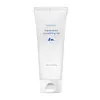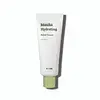What's inside
What's inside
 Key Ingredients
Key Ingredients

 Benefits
Benefits

 Concerns
Concerns

No concerns
 Ingredients Side-by-side
Ingredients Side-by-side

Water
Skin ConditioningGlycerin
HumectantButylene Glycol
Humectant1,2-Hexanediol
Skin ConditioningCarbomer
Emulsion StabilisingPolyglycerin-3
HumectantTromethamine
BufferingEucalyptus Globulus Leaf Extract
PerfumingMentha Arvensis Extract
MaskingAloe Barbadensis Leaf Extract
EmollientCymbopogon Citratus Extract
Skin ConditioningPanthenol
Skin ConditioningEthylhexylglycerin
Skin ConditioningTremella Fuciformis Polysaccharide
Emulsion StabilisingHydrolyzed Hyaluronic Acid
HumectantDisodium EDTA
Sodium Hyaluronate
HumectantErythritol
HumectantWater, Glycerin, Butylene Glycol, 1,2-Hexanediol, Carbomer, Polyglycerin-3, Tromethamine, Eucalyptus Globulus Leaf Extract, Mentha Arvensis Extract, Aloe Barbadensis Leaf Extract, Cymbopogon Citratus Extract, Panthenol, Ethylhexylglycerin, Tremella Fuciformis Polysaccharide, Hydrolyzed Hyaluronic Acid, Disodium EDTA, Sodium Hyaluronate, Erythritol
Water
Skin ConditioningCamellia Sinensis Leaf Water
MaskingPanthenol
Skin ConditioningButylene Glycol
HumectantGlycerin
HumectantCaprylic/Capric Triglyceride
MaskingButylene Glycol Dicaprylate/Dicaprate
EmollientCetearyl Alcohol
EmollientStearic Acid
CleansingSimethicone
EmollientCetearyl Olivate
Sorbitan Olivate
EmulsifyingHydroxyacetophenone
AntioxidantCetearyl Glucoside
EmulsifyingSqualane
EmollientPentaerythrityl Stearate/Caprate/Caprylate/Adipate
EmollientArginine
MaskingCarbomer
Emulsion Stabilising1,2-Hexanediol
Skin ConditioningAmmonium Acryloyldimethyltaurate/Vp Copolymer
Allantoin
Skin ConditioningXanthan Gum
EmulsifyingHydrogenated Olive Oil Unsaponifiables
EmollientMelia Azadirachta Leaf Extract
Skin ConditioningDisodium EDTA
Melia Azadirachta Flower Extract
Skin ConditioningCurcuma Longa Root Extract
MaskingGlucose
HumectantCoccinia Indica Fruit Extract
Skin ConditioningOcimum Sanctum Leaf Extract
Skin ConditioningSolanum Melongena Fruit Extract
Skin ConditioningCorallina Officinalis Extract
Skin Conditioning2,3-Butanediol
HumectantHydrogenated Lecithin
EmulsifyingGlyceryl Stearate
EmollientCholesterol
EmollientCeramide Ns
Skin ConditioningCeramide AP
Skin ConditioningCeramide As
Skin ConditioningCeramide EOP
Skin ConditioningWater, Camellia Sinensis Leaf Water, Panthenol, Butylene Glycol, Glycerin, Caprylic/Capric Triglyceride, Butylene Glycol Dicaprylate/Dicaprate, Cetearyl Alcohol, Stearic Acid, Simethicone, Cetearyl Olivate, Sorbitan Olivate, Hydroxyacetophenone, Cetearyl Glucoside, Squalane, Pentaerythrityl Stearate/Caprate/Caprylate/Adipate, Arginine, Carbomer, 1,2-Hexanediol, Ammonium Acryloyldimethyltaurate/Vp Copolymer, Allantoin, Xanthan Gum, Hydrogenated Olive Oil Unsaponifiables, Melia Azadirachta Leaf Extract, Disodium EDTA, Melia Azadirachta Flower Extract, Curcuma Longa Root Extract, Glucose, Coccinia Indica Fruit Extract, Ocimum Sanctum Leaf Extract, Solanum Melongena Fruit Extract, Corallina Officinalis Extract, 2,3-Butanediol, Hydrogenated Lecithin, Glyceryl Stearate, Cholesterol, Ceramide Ns, Ceramide AP, Ceramide As, Ceramide EOP
 Reviews
Reviews

Ingredients Explained
These ingredients are found in both products.
Ingredients higher up in an ingredient list are typically present in a larger amount.
1,2-Hexanediol is a synthetic liquid and another multi-functional powerhouse.
It is a:
- Humectant, drawing moisture into the skin
- Emollient, helping to soften skin
- Solvent, dispersing and stabilizing formulas
- Preservative booster, enhancing the antimicrobial activity of other preservatives
Butylene Glycol (or BG) is used within cosmetic products for a few different reasons:
Overall, Butylene Glycol is a safe and well-rounded ingredient that works well with other ingredients.
Though this ingredient works well with most skin types, some people with sensitive skin may experience a reaction such as allergic rashes, closed comedones, or itchiness.
Learn more about Butylene GlycolCarbomer is a polymer of acrylic acid. Its main role is to create a gel consistency.
A high amount of carbomer can cause pilling or balling up of products. Don't worry, most products contain 1% or less of carbomer.
Disodium EDTA plays a role in making products more stable by aiding other preservatives.
It is a chelating agent, meaning it neutralizes metal ions that may be found in a product.
Disodium EDTA is a salt of edetic acid and is found to be safe in cosmetic ingredients.
Learn more about Disodium EDTAGlycerin is already naturally found in your skin. It helps moisturize and protect your skin.
A study from 2016 found glycerin to be more effective as a humectant than AHAs and hyaluronic acid.
As a humectant, it helps the skin stay hydrated by pulling moisture to your skin. The low molecular weight of glycerin allows it to pull moisture into the deeper layers of your skin.
Hydrated skin improves your skin barrier; Your skin barrier helps protect against irritants and bacteria.
Glycerin has also been found to have antimicrobial and antiviral properties. Due to these properties, glycerin is often used in wound and burn treatments.
In cosmetics, glycerin is usually derived from plants such as soybean or palm. However, it can also be sourced from animals, such as tallow or animal fat.
This ingredient is organic, colorless, odorless, and non-toxic.
Glycerin is the name for this ingredient in American English. British English uses Glycerol/Glycerine.
Learn more about GlycerinPanthenol is a common ingredient that helps hydrate and soothe the skin. It is found naturally in our skin and hair.
There are two forms of panthenol: D and L.
D-panthenol is also known as dexpanthenol. Most cosmetics use dexpanthenol or a mixture of D and L-panthenol.
Panthenol is famous due to its ability to go deeper into the skin's layers. Using this ingredient has numerous pros (and no cons):
Like hyaluronic acid, panthenol is a humectant. Humectants are able to bind and hold large amounts of water to keep skin hydrated.
This ingredient works well for wound healing. It works by increasing tissue in the wound and helps close open wounds.
Once oxidized, panthenol converts to pantothenic acid. Panthothenic acid is found in all living cells.
This ingredient is also referred to as pro-vitamin B5.
Learn more about PanthenolWater. It's the most common cosmetic ingredient of all. You'll usually see it at the top of ingredient lists, meaning that it makes up the largest part of the product.
So why is it so popular? Water most often acts as a solvent - this means that it helps dissolve other ingredients into the formulation.
You'll also recognize water as that liquid we all need to stay alive. If you see this, drink a glass of water. Stay hydrated!
Learn more about Water